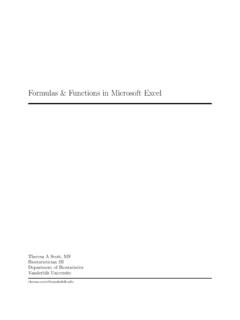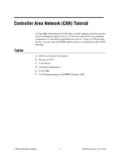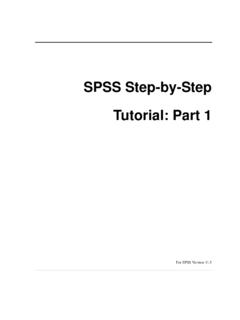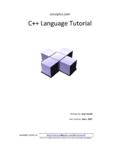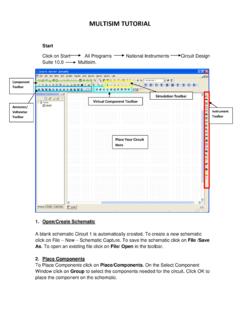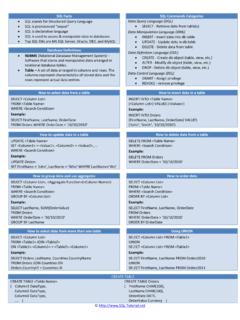Transcription of Introduction to String Matching and Modification …
1 Introduction to String Matching and Modification in R Using Regular Expressions Svetlana Eden March 6, 2007. 1 Do We Really Need Them ? Working with statistical data in R involves a great deal of text data or character strings processing, including adjusting exported variable names to the R variable name format, changing categorical variable levels, processing text data for using in LaTeX. Such tasks can be performed by using functions for String search ( or Matching ) and modification. R provides several such functions. The most commonly used ones are grep(), gsub(), strsplit().
2 When using them, it is important to know that some of their arguments are interpreted by R as regular expressions. What is a regular expression ? According to Linux help [3], regular expression is a pattern that describes a set of strings. Simply speaking, regular expression is an instruction given to a function on what and how to match or replace strings. Using regular expression may solve complicated problems (not all the problems) in String Matching and manipulation, and may reduce the time spent on R code writing and maintanence. The purpose of this presentation is to introduce regular expressions by showing several ex- amples, inspired by real problems.
3 The examples are deliberately simple to attract potential users and not to scare them off. The concept of regular expressions is implemented in several programing lanquages (for example Perl, Python). Regular expressions in R are usually restricted and help [1] is not very informative; it does not cover many topics and not all examples work. To compensate for this, R functions are written to understand Perl regular expression syntax if you specify argument perl =TRUE. You can also read Perl documentation, which is more detailed and widely available. For a quick Introduction , you can read more user friendly Python help[2].
4 As well, since its regular expressions syntax is close to R. 2 How NOT to Use Regular Expressions: Beware of Metacharac- ters As mentioned before, R String Matching and modification functions interpret some of their arguments as regular expressions. For example, the argument pattern of function gsub(). is a character String interperted as a regular expression. If a user is not aware of that he/she may get an error or fail to achieve his/her task and not noticing it. For example, we want to substitute a $ with a period in String s using function gsub(). > s = "gsub$uses$regular$expressions".
5 1. Our final result should be String s1. > s1 = " ". If we do not know that gsub() treats argument pattern as a regular expression we try to do the following. > s1 = gsub(pattern = "$", replacement = ".", "gsub$uses$regular$expressions"). > s1. [1] "gsub$uses$regular$expressions.". String s1 is not what we wanted because gsub() interpreted the character $ as a regular expressions special character. To get the correct result we have to tell gsub() to interpret $ as a regular character. This can be done by preceding $ with a double backslash. The correct solution is > s1 = gsub(pattern = "\\$", replacement = ".)
6 ", "gsub$uses$regular$expressions"). > s1. [1] " ". In regular expressions, characters $ * + . ? [ ] ^ { } | ( ) \. are called metacharacters. When Matching any metacharacter as a regular character, precede it with a double backslash. When Matching a backslash as a regular character, write four backslashes (see examples below). Examples of unintentional usage of regular expressions resulting in errors metaChar = c("$","*","+",".","?","[","^","{","|","( ","\\"). grep(pattern="$", x=metaChar, value=TRUE). grep(pattern="\\", x=metaChar, value=TRUE). grep(pattern="(", x=metaChar, value=TRUE).)]}
7 Gsub(pattern="|", replacement=".", "gsub|uses|regular|expressions"). strsplit(x=" ", split="."). Examples of correct ways of avoiding regular expression usage metaChar = c("$","*","+",".","?","[","^","{","|","( ","\\"). grep(pattern="\\$", x=metaChar, value=TRUE). grep(pattern="\\\\", x=metaChar, value=TRUE). grep(pattern="\\(", x=metaChar, value=TRUE). gsub(pattern="\\|", replacement=".", "gsub|uses|regular|expressions"). strsplit(x=" ", split="\\."). strsplit(x=" ", split=".", fixed=TRUE). 2. 3 Here They The examples in this section show the importance of using regular expressions for efficient R programming.))]}
8 Please, Meet Some of the Metacharacters Suppose we export a dataframe from a text file using function (). For the sake of this example reprodusibility we will generate this data frame rather than actually exporting it. Suppose that, after this procedure, the names of the dataframe variables contain multiple periods. > d1 = ( = c(1, 2), = c(1, + 2)). > d1. 1 1 1. 2 2 2. We would like to replace multiple periods with a single one. First, we get rid of 4 periods and then of 3 periods > names(d1) = gsub(pattern = "\\.\\.\\.\\.", replacement = ".", + names(d1)). > names(d1). [1] " " " ".
9 > names(d1) = gsub(pattern = "\\.\\.\\.", replacement = ".", names(d1)). > names(d1). [1] " " " ". The main disadvantage of this solution is when the data changes we have to rewrite the code for the new data, which is against the spirit of efficient programming. We want to minimize time spent on code maintenance and free time for the data analysis. This is when regular expressions come to the rescue. The following solution will always work, even if the names of the variable change. > d1 = ( = c(1, 2), = c(1, + 2)). > d1. 1 1 1. 2 2 2. > names(d1) <- gsub(pattern = "\\.+", replacement = ".)
10 ", x = names(d1)). > names(d1). [1] " " " ". 3. Regular expression \\.+. tells function gsub() to match and replace one or more repititions of a period. Metacharacter + is the instruction to match one or more repetitions of whatever comes before + . Here are some metacharacters and their meanings. "." matches everything except for the empty sting "". "+" the preceding item will be matched one or more times. "*" the preceding item will be matched zero or more times. "^" matches the empty String at the at the beginning of a line. When used in a character class (see explanation about character classes in the following section) means to match any character but the following ones.



